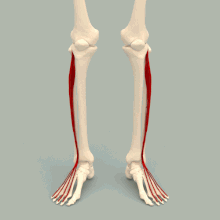Extensor digitorum longus muscle
| Extensor digitorum longus muscle |
|---|

|
| Front lower leg muscles |
| origin |
| Shin , fibula , interosseous membrane |
| approach |
| Base of the middle and foremost links of the 2nd – 5th toe |
| function |
| Dorsiflexion of the toes (metatarsophalangeal joint and interphalangial joints) and the foot (upper ankle joint), pronation in the lower ankle joint |
| Innervation |
| Deep peroneal nerve |
| Spinal segments |
| L5, S1 |
The extensor digitorum longus muscle ( Latin for "long toe extensor") is a skeletal muscle of the leg and is one of the extensors on the lower leg .
Human anatomy
The extensor digitorum longus muscle arises in humans at the front edge ( Margo anterior ) and head ( Caput fibulae ) of the fibula , at the lower edge of the lateral condyle of the tibia ( Condylus lateralis tibiae ), the interosseous membrane and the lower leg fascia ( Fascia cruris ). At the foot it ends in four tendons that pull towards the back of the toes. The peroneus tertius muscle splits off from the muscle and attaches to the outer edge of the foot.
The extensor digitorum longus muscle is responsible for dorsiflexion (pulling up) of the foot and the second to fifth toes.
Anatomy of the quadrupedal mammals
In most quadrupedal mammals, the extensor digitorum longus muscle arises together with the peroneus tertius muscle in the extensor fossa of the femur . The tendon of origin passes through the extensor sulcus of the tibia and is encased there by a bulging of the knee joint capsule in the form of a tendon sheath capsule ( vagina tendinis musculi extensoris digitorum longi ).
In ruminants , the extensor digitorum longus muscle has two muscle bellies. The tendon of the medial abdomen extends to the corolla bone of the second toe, that of the lateral muscle abdomen to the extensor process of the claw bone of the second and third toe. In horses the tendon attaches to the extensor process of the coffin bone , in predators to the unguicular process of the claw bone of the second to fifth toe. In ungulates , the tendon tendons are surrounded by tendon sheaths and / or bursa are underlain.
In quadruped mammals, the muscle stretches the toe joints and flexes the ankle .
See also
literature
- Wayne Vogl, Adam WM Mitchell: Anatomy for Students . Elsevier, Urban & FischerVerlag 2007, ISBN 978-3-437-41231-8 , p. 578.
- Franz-Viktor Salomon: muscle tissue . In: Anatomy for veterinary medicine . 2nd ext. Edition. Enke Stuttgart 2008, ISBN 978-3-8304-1075-1 , p. 232.
